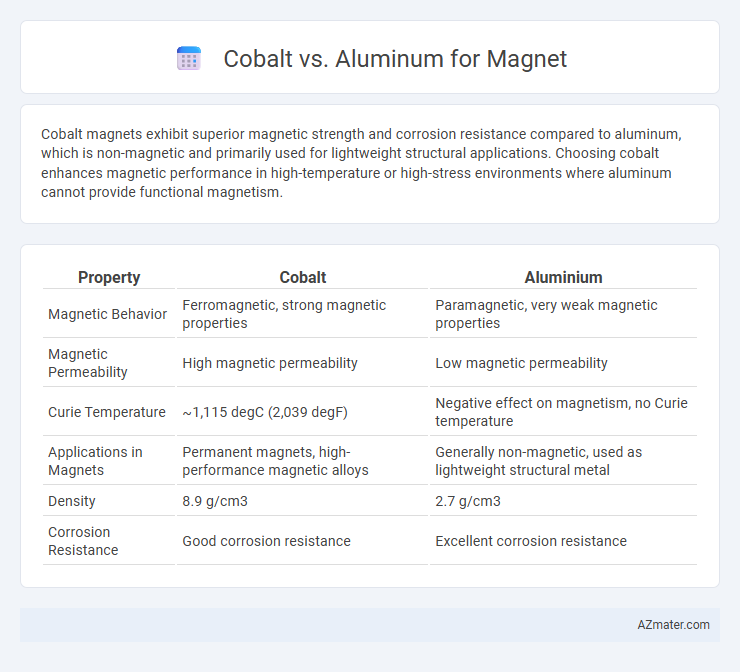Cobalt magnets exhibit superior magnetic strength and corrosion resistance compared to aluminum, which is non-magnetic and primarily used for lightweight structural applications. Choosing cobalt enhances magnetic performance in high-temperature or high-stress environments where aluminum cannot provide functional magnetism.
Table of Comparison
| Property | Cobalt | Aluminium |
|---|---|---|
| Magnetic Behavior | Ferromagnetic, strong magnetic properties | Paramagnetic, very weak magnetic properties |
| Magnetic Permeability | High magnetic permeability | Low magnetic permeability |
| Curie Temperature | ~1,115 degC (2,039 degF) | Negative effect on magnetism, no Curie temperature |
| Applications in Magnets | Permanent magnets, high-performance magnetic alloys | Generally non-magnetic, used as lightweight structural metal |
| Density | 8.9 g/cm3 | 2.7 g/cm3 |
| Corrosion Resistance | Good corrosion resistance | Excellent corrosion resistance |
Introduction to Cobalt and Aluminium in Magnet Applications
Cobalt and aluminium serve distinct roles in magnet applications, with cobalt known for its strong magnetic properties and high Curie temperature, making it ideal for permanent magnets and high-performance electromagnets. Aluminium, while non-magnetic itself, is often used in magnet assemblies for its lightweight, corrosion resistance, and excellent thermal conductivity, enhancing the overall stability and performance of magnetic systems. The choice between cobalt and aluminium depends on the specific magnetic, mechanical, and thermal requirements of the application.
Magnetic Properties: Cobalt vs Aluminium
Cobalt exhibits strong ferromagnetic properties with a high Curie temperature around 1,115degC, making it highly suitable for permanent magnets and magnetic recording applications. In contrast, aluminium is paramagnetic and lacks intrinsic magnetism, rendering it ineffective for magnet-related uses. The significantly higher magnetic permeability and saturation magnetization of cobalt distinguish it from aluminium in magnetic performance.
Electrical Conductivity Comparison
Cobalt exhibits lower electrical conductivity compared to aluminum, with cobalt's conductivity typically around 1.7 x 10^6 S/m, whereas aluminum is significantly higher at approximately 3.5 x 10^7 S/m. This substantial difference influences their performance in magnetic applications where electrical losses and eddy currents are critical factors. Choosing aluminum for magnet casings or components often reduces energy losses due to its superior conductivity, while cobalt is favored in magnetic cores for its strong magnetic properties despite lower conductivity.
Chemical Stability and Corrosion Resistance
Cobalt exhibits superior chemical stability and corrosion resistance compared to aluminum, making it ideal for high-performance magnets in harsh environments. Its corrosion resistance withstands oxidative and acidic conditions without significant degradation, unlike aluminum, which is prone to forming an oxidized surface layer that can compromise magnetic performance. These properties enable cobalt-based magnets to maintain reliability and longevity in demanding industrial applications.
Material Cost and Availability
Cobalt magnets, especially samarium-cobalt types, are considerably more expensive than aluminum-based magnets due to the high cost and limited supply of cobalt, an element often sourced from geopolitically sensitive regions. Aluminum, while not typically used as a primary magnetic material, is abundant and inexpensive, making aluminum-based alloys or composites more cost-effective and widely accessible for applications requiring non-rare-earth alternatives. The scarcity of cobalt drives up material costs and complicates supply chains, whereas aluminum's abundant availability enhances production scalability and reduces overall expenses.
Manufacturing and Processing Techniques
Cobalt magnets, primarily produced using sintering and casting techniques, offer superior magnetic performance and temperature resistance compared to aluminum-based magnets, which are typically manufactured through powder metallurgy and extrusion processes. Cobalt's high melting point and hardness demand specialized high-temperature sintering and precision machining, whereas aluminum magnets benefit from lightweight properties and easier machinability but exhibit lower magnetic strength. Advanced manufacturing methods like hot isostatic pressing for cobalt enhance density and magnetic alignment, while aluminum alloys require complex alloying and heat treatment to optimize magnetic characteristics.
Performance in High-Temperature Environments
Cobalt magnets exhibit superior performance in high-temperature environments due to their high Curie temperature, often exceeding 900degC, maintaining strong magnetic properties where aluminium-based magnets degrade. Aluminium magnets, typically aluminum-nickel-cobalt (Alnico), offer good thermal stability up to around 550degC but suffer from reduced coercivity and magnetic strength beyond this range. For applications requiring consistent magnetism under extreme heat, cobalt magnets provide enhanced reliability and longevity.
Environmental Impact and Sustainability
Cobalt magnets, often used in high-performance applications, involve intensive mining processes that cause significant environmental degradation and raise ethical concerns due to labor practices in cobalt-producing regions. Aluminium, widely recycled and abundant, offers a more sustainable alternative with lower environmental impact when used as a magnet casing or component but lacks the magnetic properties of cobalt alloys. Prioritizing recycling and sourcing enables reduction of ecological footprints for both materials, with aluminium's recyclability making it preferable for long-term sustainability in magnet manufacturing.
Common Industrial Uses of Cobalt and Aluminium Magnets
Cobalt magnets, known for their high magnetic strength and corrosion resistance, are commonly used in industrial applications such as electric motors, hard disk drives, and high-performance sensors. Aluminium magnets, although weaker magnetically, are valued for their lightweight properties and find uses in applications requiring non-magnetic materials combined with structural support, such as aerospace components and electronic casings. The choice between cobalt and aluminium magnets depends on the need for magnetic intensity versus mechanical strength and weight considerations in industrial designs.
Which Material is Best for Your Magnet Needs?
Cobalt offers superior magnetic properties such as higher coercivity and greater resistance to demagnetization, making it ideal for high-performance magnets in applications like aerospace and precision instruments. Aluminium, while non-magnetic itself, is often used in alloy form to enhance the strength and corrosion resistance of magnets, especially in cost-sensitive or lightweight designs. Choosing between cobalt and aluminum depends on your specific requirements for magnetic strength, durability, and application environment.

Infographic: Cobalt vs Aluminium for Magnet
 azmater.com
azmater.com